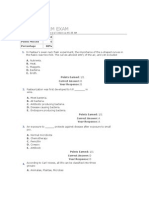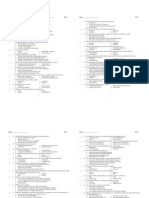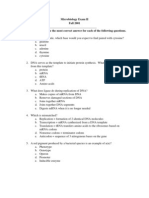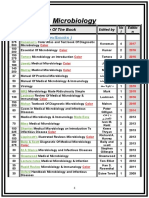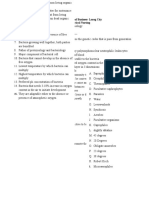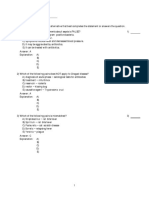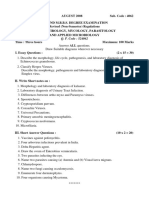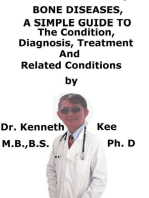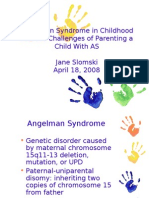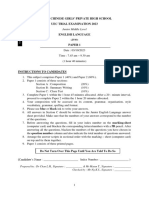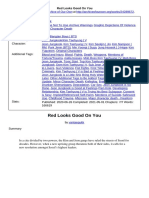4
4
Uploaded by
Carl MannCopyright:
Available Formats
4
4
Uploaded by
Carl MannCopyright
Available Formats
Share this document
Did you find this document useful?
Is this content inappropriate?
Copyright:
Available Formats
4
4
Uploaded by
Carl MannCopyright:
Available Formats
Exam Name___________________________________
MULTIPLECHOICE.Choosetheonealternativethatbestcompletesthestatementoranswersthequestion. 1) Thesumofallbiosyntheticreactionsinacellisknownas A) synthatabolism. B) anabolism. C) metabolism. D) catabolism. 2) Phosphorusinmicroorganismscanbefoundin A) organiccompounds. B) inorganiccompounds. C) bothorganicandinorganiccompounds. D) neitherorganicnorinorganiccompoundsbutinfreeelementalforminthecell. 3) Chemoorganotrophsusewhichofthefollowingasanenergysource? A) inorganiccompounds B) organiccompounds C) bothorganicandinorganiccompounds D) eitherorganicorinorganiccompounds,dependingontheenvironment 4) WhichstatementisNOTtrue? A) Somebacteriaareabletousenitratesornitrogengasastheirnitrogensource. B) Mostbacteriaarecapableofusingammoniaastheirsolenitrogensource. C) Mostavailablenitrogenisinorganicforms. D) Nitrogenisamajorcomponentofproteinsandnucleicacids. 5) Allorganismsrequirethemacronutrients A) phosphorus,potassium,andmagnesium. C) calcium,potassium,andmagnesium. 1)
2)
3)
4)
5) B) phosphorus,potassium,andsodium. D) potassium,magnesium,andsodium. 6)
6) WhichnutrientfunctionsBOTHasanenzymaticcofactorandasastabilizerofribosomesand nucleicacids? A) phosphorus B) potassium C) calcium D) magnesium 7) Regulationofanenzymesactivityoccurs A) atanypointontheenzymaticproductionpathway. B) duringtheproductionoftheenzyme. C) beforetheenzymeisproduced. D) whentheenzymealreadyexistsinthecell. 8) Siderophores A) bindironandtransportitintothecell. B) areakeycomponentinthecytochromes. C) developwhenerrorsinmembranesynthesisoccur. D) helpmaintainosmoticbalanceinseawatermicrobes.
7)
8)
9) WhichstatementisCORRECT? A) Bothmicronutrientsandgrowthfactorsareorganiccompoundsessentialforcellgrowth. B) Micronutrientsareorganic,butgrowthfactorsaremetals. C) Bothmicronutrientsandgrowthfactorsareessentiallymetals. D) Micronutrientsaremetals,butgrowthfactorsareorganic. 10) Aseptictechniquerefersto A) themicrobialinoculumplacedintoatesttubeorontoaPetriplate. B) cleanlinessinthelaboratory. C) theautoclaveandothersterilizingprocedures. D) thepreventionofcontamination. 11) Allostericenzymeshavetwoimportantbindingsites.Thesearethe A) activeandinhibitorysites. B) allostericandeffectorsites. C) allostericandpassivesites. D) activeandallostericsites. 12) IfG0 isnegative,thereactionis A) endergonicandrequirestheinputofenergy. B) exergonicandrequirestheinputofenergy. C) exergonicandenergywillbereleased. D) endergonicandenergywillbereleased. 13) Activationenergyistheenergy A) absorbedasG 0 movesfromnegativetopositive. B) sometimesreferredtoascatabolicenergy. C) givenoffastheproductsinachemicalreactionareformed. D) requiredtotransformallreactantsintotheirreactivestate. 14) Acatalyst A) changestherateofthereactionbutdoesnotchangetheendamountofproducts. B) changesboththerateofareactionandtheamountoftheproductthatwillbeobtainedasthe reactioniscompleted. C) increasestheamountofreactantsproducedbutdoesnotchangetherate. D) makespossibleotherwiseimpossiblereactions. 15) Theportionofanenzymetowhichsubstratesbindisreferredtoasthe A) junctionofvanderWaalsforces. B) catalysissite. C) activesite. D) substratecomplex. 16) WhichstatementisTRUE? A) Coenzymesandprostheticgroupsaretechnicallynotboundtotheirrespectiveenzymes. B) Coenzymesandprostheticgroupsbothbindtightlytotheirrespectiveenzymes. C) Prostheticgroupsbindtightlytotheirrespectiveenzymes. D) Coenzymesbindtightlytotheirrespectiveenzymes. 17) Ifanoxidationreactionoccurs,areductionreactionmustalsooccurbecause A) thatiswhatredoxmeans. B) Actually,reductionisnotnecessaryifoxidationoccurs. C) halfreactionsarewrittenthatway. D) electronsdonotgenerallyexistaloneinsolution.
9)
10)
11)
12)
13)
14)
15)
16)
17)
18) NAD+ /NADHareinvolvedprimarilyin________reactions,whileNADP + /NADPHareinvolved in________reactions. A) biosynthetic(anabolic)/energy-generating(catabolic) B) energy-generating(catabolic)/biosynthetic(anabolic) C) energy-generating(catabolic)/bothenergy-generating(catabolic)andbiosynthetic (anabolic) D) bothenergy-generating(catabolic)andbiosynthetic(anabolic)/bothenergy -generating (catabolic)andbiosynthetic(anabolic) 19) Covalentmodificationofanenzymeoftenincludes A) rearrangementofthecomponentsoftheenzymeproper. B) bindingoftheenzymetospecificcytoplasmicribosomes. C) additionordeletionofsomesmallmolecule. D) noneoftheabove. 20) Themostimportanthigh-energyphosphatecompoundinlivingorganismsis A) ATP. B) GTP. C) glucose. D) RNA. 21) TheEmbden -Meyerhof-Pamaspathwayisanothernamefor A) NADHproduction. B) thecitricacidcycle. C) glycolysis. D) electrontransport. 22) ThenetgainofATPpermoleculeofglucosefermentedis A) 1. B) 2. C) 4.
18)
19)
20)
21)
22) D) 8. 23)
23) Theroadblockcreatedbytheformationofareducedelectroncarrierisovercomeinfermentation bythe A) reductionofNADHbacktoNAD + . B) reductionofNAD + backtoNADH. C) oxidationofNADHbacktoNAD + . D) oxidationofNAD + backtoNADH.
24) Whenwritinghalfreactions, A) thereductionpotentialsarebyconventiondescribedintermsofoxidation. B) thefinalproduct(s)mustbeatomicallybalancedwiththebeginningsubstrate(s). C) theunitsareinjoulesforE0 . D) thepHofthereactionshouldbedescribedbecauseitcannotbeassumedtobe7.0. 25) Fromthestandpointofthemicroorganism,inglycolysisthecrucialproductis A) ATP;thefermentationproductsarewasteproducts. B) notrelevantbecauseglycolysisisnotamajorpathway. C) CO 2 ;ATPisawasteproduct. D) ethanolorlactate;ATPisawasteproduct. 26) Inaerobicrespiration,thefinalelectronacceptoris A) oxygen. B) ATP.
24)
25)
26) C) water. D) hydrogen. 27)
27) WhichofthefollowinggroupsisNOTmembraneassociated? A) NADHdehydrogenases B) cytochromes C) flavoproteins D) Allofthesearemembraneassociated.
28) Duringelectrontransportreactions, A) OH- accumulatesontheoutsideofthemembranewhileH + accumulatesontheinside. B) OH- accumulatesontheinsideofthemembranewhileH + accumulatesontheoutside. C) bothOH - andH + accumulateontheinsideofthemembrane. D) bothOH - andH + accumulateontheoutsideofthemembrane. 29) Therisingofbreaddoughistheresultof A) oxygenbeingreleased. C) biotinproduction. 30) Thecitricacidcycle A) delineatestheoxidationofpyruvate. B) producesNADHasitprogresses. C) allowsforthecompleteoxidationofglucose. D) doesalloftheabove. 31) Aseachmoleculeofpyruvatetraversesthecitricacidcycle,howmanymoleculesofCO 2 are generated? A) 1 B) 2 C) 3 D) 4 32) Chemolithotrophsare A) phototrophs.
28)
29) B) fermentation. D) flourgainingelectrons. 30)
31)
32) B) heterotrophs. C) organotrophs. D) autotrophs. 33) D) triglycerides. 34)
33) Foracarbonsource,chemoorganotrophsgenerallyusesuchcompoundsas A) sunlight. B) glucose. C) carbondioxide. 34) Prokaryoticpolysaccharidesaresynthesizedfrom A) negativeaminoacids. B) starch/glycogencomplexes. C) saturatedfattyacids. D) onlyoneoftwoactivatedformsofglucose(UDPGandUDPG). 35) Theprocessbywhichglucoseissynthesizedwithinthecellis A) pentose. B) gluconeogenesis. C) glycolysis. D) peptidogenesis.
35)
36) Themacronutrientthatcomprisesabout50%ofthedryweightofatypicalbacterialcellis A) oxygen. B) nitrogen. C) carbon. D) protein. 37) Thejoiningofanenzymeandsubstrate(s)dependsonweakbonds,suchas A) hydrophobicinteractions. B) vanderWaalsforces. C) hydrogenbonds. D) alloftheabove. 38) ThenumberofprotonsconsumedbyanATPasepermoleculeofATPformedis A) 1. B) 3-4. C) 6-8. D) 10. 39) Twospecificcellularreactionsinacellthatrequireenergyfromtheprotonmotiveforceare A) communicationandmetabolism. B) biosynthesisandpolymerization. C) respirationandfermentation. D) iontransportandflagellarrotation. 4
36)
37)
38)
39)
40) Oneexampleofanelectronacceptorthatcanbeusedinanaerobicrespirationis A) pyruvate. B) water. C) NADH. D) nitrate. TRUE/FALSE.WriteTifthestatementistrueandFifthestatementisfalse. 41) Achemotrophuseschemicalsforenergy,whileaphototrophuseslightforenergy. 42) Carbonandnitrogenareconsideredmicronutrients. 43) Allprokaryotesrequireanorganiccarbonsource. 44) VitaminsareNOTconsideredgrowthfactors. 45) Mostmicroorganismshavethesamegeneralnutritionalrequirements,somostmicroorganisms cangrowonthesamemedia. 46) Energycanbemeasuredinkilojoules. 47) Regulationoftheamountofenzymesynthesizedoccursonlyatthegenelevel. 48) Inagivenchemicalreaction,ifthefreeenergyofformationisknownforeachofthereactantsand eachoftheproducts,thechangeinfreeenergycanbecalculatedforthereaction. 49) Free-energycalculationsaredependentontheratesofthereactions. 50) Enzymesarebiologicalcatalysts. 51) Theoretically,allenzyme-catalyzedreactionsarereversiblebythesameenzyme. 52) Ifthenameofacompoundendsin -ase,itislikelyanenzyme. 53) Ifasubstanceisreduced,itgainselectrons. 54) ThetendencytobecomeoxidizedorreducedisexpressedasthereductionpotentialinVolts. 55) Inanaerobicmetabolism,theelectrondonorisoftenreferredtoasanenergysource. 56) Feedbackinhibitionorcovalentmodificationisgenerallysufficientfortheregulationofgene expression. 57) Coenzymesincreasethediversityofchemicalreactionspossibleinacell. 58) TheenergyreleasedfromthehydrolysisofcoenzymeAisconservedinthesynthesisofATP. 59) Insubstrate-levelphosphorylation,ATPstorageisdepletedduringthestepsincatabolismofthe fermentablecompounds. 60) Wheneverabacteriumundergoesfermentation,ethanolisabyproduct. 5
40)
41) 42) 43) 44) 45)
46) 47) 48)
49) 50) 51) 52) 53) 54) 55) 56)
57) 58) 59)
60)
61) Inelectrontransportsystems,theelectroncarriersaremembraneassociated. 62) Hemeprostheticgroupsareinvolvedinelectrontransferwithquinones. 63) Duringtheelectrontransportprocess,protonsandelectronsbecomephysicallyseparatedinthe cellmembrane. 64) AMPandmethylgroupscanplayapartincovalentmodification;ADPdoesnotfunctionin covalentmodification. 65) ThenetresultofelectrontransportisthegenerationofapHgradientandanelectrochemical potentialacrossthemembrane. 66) Inhibitorsblockbothelectronflowandtheestablishmentoftheprotonmotiveforce. 67) Oxalacetate,generatedinthecitricacidcycle,isimportantbothinthegenerationofcertainamino acidsandintheformationofphosphoenolpyruvate. 68) EachmoleculeofNADPH +yields3moleculesofATP. 69) Thetheoreticalmaximumyieldfromeachmoleculeofglucoseduringaerobicrespirationis between30and35moleculesofATP. 70) Controllingtheactivityofanenzymeisaninefficientuseoftheorganismsenergy. 71) Polysaccharidesarekeycellwallconstituents. 72) Aminoacidscanbegroupedintostructurallyrelatedfamiliesthathavesimilarbiosyntheticsteps. 73) Inosinicacidistheprecursorofthepyrimidines. 74) Thedistinguishingcharacteristicofanunsaturatedfattyacidistheinclusionofoneormoredouble bondsinthehydrophobicportionofthemolecule. 75) ThethirdcarbonofaglycerolbackboneusuallycontainsapolargroupintheBacteriaandthe Eukarya. SHORTANSWER.Writethewordorphrasethatbestcompleteseachstatementoranswersthequestion. 76) Thetermusedtorefertoallthechemicalprocessestakingplacewithinacellis________. 77) ________istheabilitytodowork. 78) The________requiredorreleasedtoformagivenmoleculefromitsconstituentelements iscalled________. 79) ________isthetermusedtodescribethetemporarycombinationoftheenzymeandthe reactant. 6 76) 77) 78)
61) 62) 63)
64)
65)
66) 67)
68) 69)
70) 71) 72) 73) 74)
75)
79)
80) ThePasteureffectinvolvesmetabolicallyversatilemicrobessuchas Saccharomyces cerevisiaethatfirstperform________metabolism.Afterthisprocess,theyeastswitchesto ________metabolismwheretwobyproductsare________and________. 81) Energyreleasedasaresultofoxidation-reductionreactionsisusuallyconservedinthe ________. 82) ________aredifferentenzymesthatcatalyzethesamereactionbutaresubjecttodifferent regulatorycontrols. 83) Theenzymeresponsibleforsplittingfructose1,6-bisphosphateintotwothree-carbon moleculesis________. 84) TheenzymethatcatalyzestheconversionoftheprotonmotiveforceintoATPis________, amoleculethatcontainstwomajorparts,________and________.Thisreactionisknown as________. 85) Theprocessbywhichorganismssynthesizethechemicalsubstancesofwhichtheyare composedis________. 86) Anenzymethatmovesanaminogroupfromonemoleculetoanotherisknownasa(n) ________. 87) Anenrichedmediumisacomplexmediumtowhichadditionalnutrients,suchas ________or________,areadded. 88) Inbiochemistry,oxidationsandreductionsfrequentlyinvolvethetransferofa(n) ________alongwitha(n)________. 89) Twomechanismsforenergyconservationinchemoorganotrophsare________and ________. 90) Withregardtooxygen,glycolysisisa(n)________process. 91) Metabolicdiversityinrespirationandphotosynthesisrevolvesaroundacommonprocess, whichisgenerationofa(n)________. ESSAY.Writeyouranswerinthespaceprovidedoronaseparatesheetofpaper. 92) Explainthedifferencebetweenchemicallydefinedandundefined(complex)media.
80)
81)
82)
83)
84)
85)
86)
87)
88)
89)
90) 91)
93) Explainthecircumstancesunderwhichthesamesubstance(molecule)canbeeitheranelectrondonororan electronacceptor. 94) Explainthedifferencebetweenfermentationandrespirationintermsofelectrontransfer. 95) DescribethebiochemicaleventsfoundintheEmbden -Meyerhof-Pamaspathway.Includethemajorreactants, products,andenzymes.Includesuchtermsas:aldolase,glyceraldehyde3 -phosphate,1,3-bisphosphoglyceric acid,phosphoenolpyruvate,andpyruvate. 7
96) Discusswhyenergyyieldinanorganismundergoinganaerobicrespirationislessthanthatofanorganism undergoingaerobicrespiration. 97) Explainbrieflythebiosyntheticandbioenergeticrolesofthecitricacidcycle. 98) Writeabriefdefinitionoffeedbackinhibition. 99) Explainexergonicandendergonicintermsoffree-energycalculations. 100) Explainwhatanenzymemustaccomplishtocatalyzeaspecificreaction. 101) Explainingeneraltermstheprincipleofallostery. 102) Explainwhytheamountofenergyreleasedinaredoxreactiondependsonthenatureofboththeelectron donorandtheelectronacceptor.
AnswerKey Testname:UNTITLED4
1) 2) 3) 4) 5) 6) 7) 8) 9) 10) 11) 12) 13) 14) 15) 16) 17) 18) 19) 20) 21) 22) 23) 24) 25) 26) 27) 28) 29) 30) 31) 32) 33) 34) 35) 36) 37) 38) 39) 40) 41) 42) 43) 44) 45) 46) 47) 48) 49) 50)
B C B C A D D A D D D C D A C C D B C A C B C B A A D B B D C D B D B C D B D D TRUE FALSE FALSE FALSE FALSE TRUE FALSE TRUE FALSE TRUE 9
AnswerKey Testname:UNTITLED4
51) 52) 53) 54) 55) 56) 57) 58) 59) 60) 61) 62) 63) 64) 65) 66) 67) 68) 69) 70) 71) 72) 73) 74) 75) 76) 77) 78) 79) 80) 81) 82) 83) 84) 85) 86) 87) 88) 89) 90) 91) 92)
TRUE TRUE TRUE TRUE TRUE FALSE TRUE TRUE FALSE FALSE TRUE FALSE TRUE FALSE TRUE TRUE TRUE FALSE FALSE FALSE TRUE TRUE FALSE TRUE TRUE metabolism Energy energy/freeenergyofformation Enzyme-substratecomplex aerobicorrespiration/anaerobicorfermentation/carbondioxide/ethanol(lasttwoeitherorder) synthesisofenergy-richcompounds Isozymes aldolase ATPsynthase(ATPase)/F 1 /F0 /oxidativephosphorylation(secondandthirdineitherorder) anabolism transaminase anytwo:beefextract,blood,casein,milkprotein,peptone,serum,tryptone,yeastextract electron/proton fermentation/respiration(eitherorder) anoxic(anaerobic) protonmotiveforce Definedmediaarepreparedbyaddingindividualpurechemicalsinknownquantities.Inthisway,themedium itselfcanbeexplicitlydefined.Forexample,5mMNaCl,3mMKH 2 PO4 ,1.5mMNH 4Cl,2.5%glucose,and3% acetateisadefinedmedium,becauseeachingredientaddedisataknownconcentrationandthechemicalspresent areknown.Complexmedianeedsonlytocontainoneundefinedproducttobeconsideredcomplexorundefined.An exampleofanundefinedmediumis5mMNaCl,2.5%tryptoneand2.5%yeastextract,becausebothtryptoneand yeastextractarenotindividualchemicalstructuresbutinsteadcontainanassortmentofcompoundsatunknown (imprecise)quantities.
10
AnswerKey Testname:UNTITLED4
93) Answersshouldexplainthatnotallmoleculesarestrictlyoneortheother,andeachmoleculemustbecomparedto theotherinapairtodeterminetheelectronacceptorandwhichisanelectrondonor. 94) Respirationshouldbedistinguishedasusingoxygen(oranoxygensubstitute)asitsterminalelectronacceptor,while fermentationusesothercompounds,suchascarbonate,ferriciron,andnitrate,aselectrontransferringagents. 95) Figure4.14inthetextbookillustratesacompleteanswer. 96) Onepossibleexplanationcouldpointtothesubstrate-levelphosphorylationprocessitselfasbeinglessenergy yieldingthan(aerobic)oxidativephosphorylation.Anotherreasonisthefateofpyruvateitself,wherefermentationis unabletotakeitthroughthehigherenergyyieldingprocess,whichrequiresO2 asaterminalelectronacceptor.Other answerscoulddiscusstheE0beinggreatestwiththeO2 /H2 Oredoxcoupleinaerobicmetabolismcomparedto anaerobicredoxcouples. 97) Someofthemoleculesgeneratedduringthecitricacidcycle,suchas-ketoglutarate,oxalacetate,andsuccinyl-CoA, canserveasprecursorsforthebiosynthesisofcriticalcellularcomponentssuchasaminoacids,chlorophyll,and cytochromes.ThebioenergeticcomponentofthecycleshouldbedescribedinthecontextofFADHandNADH electrondonorsstoringenergypotential,usableinelectrontransportwhereO2 isreducedtowater. 98) Answerswillvary,buttheemphasisshouldbeontheroleofaccumulatedproductsthatbindtoallostericsitesin enzymes.Thisallostericbindinginteractionchangestheproteinintoaninactiveconformation,andthereforedoesnot permitaccessfornewsubstratestobindtotheactivesitesonthesameenzymes.Studentsshouldalsoexplainthatthe absenceofboundallostericsitespermitsactivesitebindingandconsequentlyallowsthepathwaytobeuninhibited. 99) Apositivechangeinfreeenergy(G 0 )meansthereactionneedsenergyinputtooccur(calledendergonic),whereasa negativeG0 needsnoenergyinputandactuallyreleasesexcessenergy(calledexergonic). 100) Answerswillvary,butthefocusoftheanswershouldbeonovercomingtherequiredactivationenergy. 101) Answerswillvarybutshouldexplainthatconformational(proteinfolding)changesoccurdependingonwhat binds/interactswithaproteinaceousenzyme.Anunderlyingprinciplethatshouldbeaddressedisthatonlycertain enzymeconformationsareactive,whileothersarenotactive. 102) Answersshouldemphasizethatenergydoesnotcomefromspecificmoleculesbutratherfromthedifferencein reductionpotentialbetweentwomolecules.Forexample,assigningarbitraryvaluesandsubtractingthemfromone anotherbycomparingtwodifferentelectronacceptorstoonedonorwouldindicatedifferencesinenergyforan electronacceptor.Inasimilarway,thiscouldalsobeshowntomathematicallyexplainelectrondonorshavingan equalroleindeterminingE0.
11
You might also like
- Test Bank For Microbiology 2nd Edition by Wessner Chapter 8 Not IncludedDocument25 pagesTest Bank For Microbiology 2nd Edition by Wessner Chapter 8 Not Includeda195840229100% (3)
- Practice-Midterm 1 Biol 1101Document6 pagesPractice-Midterm 1 Biol 1101Megadirectioner 21No ratings yet
- Test Bank For Nesters Microbiology A Human Perspective 10th EditionDocument39 pagesTest Bank For Nesters Microbiology A Human Perspective 10th EditionDevin MckayNo ratings yet
- c1 Microbiology Tortora TestbankDocument18 pagesc1 Microbiology Tortora Testbankwhitewave25No ratings yet
- Microbiology Quiz: (A Handbook for Competitive Exam)From EverandMicrobiology Quiz: (A Handbook for Competitive Exam)Rating: 4 out of 5 stars4/5 (3)
- Biochemistry MCQDocument11 pagesBiochemistry MCQSurajit Bhattacharjee100% (1)
- Micro Exam 2Document15 pagesMicro Exam 2Ana Gonzalez100% (1)
- 2Document10 pages2Carl Mann100% (1)
- 3Document10 pages3Carl MannNo ratings yet
- Chapter 7, 10, 11, 12, 13Document18 pagesChapter 7, 10, 11, 12, 13Claudia Keith McBroom43% (7)
- Midterm Exam 1Document12 pagesMidterm Exam 1Todd AllenNo ratings yet
- 1Document10 pages1Carl Mann100% (1)
- CHPT 3-4 Practice QuizDocument5 pagesCHPT 3-4 Practice QuizShanti Loyd100% (1)
- Microbiology Chapter 2 Test Bank - 14th EditionDocument25 pagesMicrobiology Chapter 2 Test Bank - 14th EditionAnmol33% (3)
- BIO Ch7 STUDY GUIDEDocument7 pagesBIO Ch7 STUDY GUIDETychi WangNo ratings yet
- Microbiology Study GuideDocument9 pagesMicrobiology Study GuideMonica E. AgogoNo ratings yet
- MICRO (1) Fundamentals of Microbiology - Dra - AbuevaDocument16 pagesMICRO (1) Fundamentals of Microbiology - Dra - AbuevaCindy Mae Macamay100% (1)
- The Immune Response: Anca Bacârea, Alexandru SchiopuDocument36 pagesThe Immune Response: Anca Bacârea, Alexandru Schiopukalaivani100% (1)
- Microbiology Exam II Fall 2001 Name: - Multiple Choice: Circle The Most Correct Answer For Each of The Following Questions. (2 Points Each)Document8 pagesMicrobiology Exam II Fall 2001 Name: - Multiple Choice: Circle The Most Correct Answer For Each of The Following Questions. (2 Points Each)Jini Luckie0% (1)
- Practice Questions 2010Document2 pagesPractice Questions 2010sylvia_andrzejewski0% (1)
- History and Branches of MicrobiologyDocument77 pagesHistory and Branches of Microbiologyrafaqat ahmedNo ratings yet
- Microbiology QuestionsDocument6 pagesMicrobiology Questionsburhaninho0% (1)
- c14 Microbiology Tortora TestbankDocument19 pagesc14 Microbiology Tortora Testbankwhitewave25No ratings yet
- MicrobiologyDocument9 pagesMicrobiologyWenxinn JCFNo ratings yet
- Genetics Module ADocument51 pagesGenetics Module AKL TongsonNo ratings yet
- c26 Microbiology Tortora TestbankDocument16 pagesc26 Microbiology Tortora Testbankwhitewave25No ratings yet
- Microbiology Chapter 1Document18 pagesMicrobiology Chapter 1Julio CantilloNo ratings yet
- 03 Adaptive Immune SystemDocument14 pages03 Adaptive Immune SystemEnea NastriNo ratings yet
- Anatomy and Physiology Placement Exam 2 Practice With Answers at End!Document9 pagesAnatomy and Physiology Placement Exam 2 Practice With Answers at End!Olalekan OyekunleNo ratings yet
- FAQ in MicrobiologyDocument117 pagesFAQ in MicrobiologyVenkatesh Arumugam100% (2)
- Exam2practice ThirdDocument3 pagesExam2practice Thirdpaola100% (1)
- Pharma ExamDocument7 pagesPharma ExamGeno Adrian T PampangaNo ratings yet
- 2018 NMAT REVIEW Reinforcement - Social Science Module BDocument2 pages2018 NMAT REVIEW Reinforcement - Social Science Module BEllah GutierrezNo ratings yet
- MULTIPLE CHOICE. Choose The One Alternative That Best Completes The Statement or Answers The QuestionDocument20 pagesMULTIPLE CHOICE. Choose The One Alternative That Best Completes The Statement or Answers The Questionmiamikiko100% (4)
- AUTOIMMUNEDocument75 pagesAUTOIMMUNEEva Boje-JugadorNo ratings yet
- Immunology NotesDocument131 pagesImmunology NotesSuganthiVasanNo ratings yet
- 4-Microbiology & ParasitologyDocument2 pages4-Microbiology & ParasitologyIbrahimFikryNo ratings yet
- Immunology NotesDocument8 pagesImmunology NotesSumit Mukherjee100% (1)
- Pharmacology QuestionsDocument20 pagesPharmacology Questionsdelluismanuel100% (2)
- Alterations in Urinary EliminationDocument76 pagesAlterations in Urinary EliminationJenny Tran80% (5)
- EXAM II Study Guide (Microbiology)Document25 pagesEXAM II Study Guide (Microbiology)Spencer ThomasNo ratings yet
- Basic Concepts: NMAT Review: Inorganic and Organic ChemistryDocument34 pagesBasic Concepts: NMAT Review: Inorganic and Organic ChemistryEugene Concha100% (1)
- C 9Document11 pagesC 9Tammie Gore100% (6)
- Microbiology Exam 1Document2 pagesMicrobiology Exam 1croline0% (1)
- Flashcards - MicrobiologyDocument26 pagesFlashcards - MicrobiologyAngela Carrillo TrianoNo ratings yet
- MC Chapter 48 TestDocument14 pagesMC Chapter 48 Testbori0905100% (2)
- AP Bio Unit 7 Study Guide Chapter 43Document7 pagesAP Bio Unit 7 Study Guide Chapter 43Huma KhanNo ratings yet
- Prelims Micropara LecDocument14 pagesPrelims Micropara LecBSN1F- JACILDO, KUH KYLA C.No ratings yet
- C 8Document11 pagesC 8Tammie Gore100% (5)
- J201 Quiz IIDocument5 pagesJ201 Quiz IItimweaveNo ratings yet
- C8e 12 Test BankDocument22 pagesC8e 12 Test BankIsrael Wootton100% (1)
- Gastrointestinal Tract System NotesDocument8 pagesGastrointestinal Tract System NotesCarl Elexer Cuyugan Ano100% (1)
- c23 Microbiology Tortora TestbankDocument16 pagesc23 Microbiology Tortora Testbankwhitewave25No ratings yet
- Med University Question PapersDocument17 pagesMed University Question Paperssushmitha poojaNo ratings yet
- Bone Diseases, A Simple Guide To The Condition, Diagnosis, Treatment And Related ConditionsFrom EverandBone Diseases, A Simple Guide To The Condition, Diagnosis, Treatment And Related ConditionsNo ratings yet
- CH 8 QDocument31 pagesCH 8 QdenisseumalibautistaNo ratings yet
- Biology Life on Earth with Physiology 11th Edition Audesirk Test Bank all chapter instant downloadDocument42 pagesBiology Life on Earth with Physiology 11th Edition Audesirk Test Bank all chapter instant downloadmiskonvicfel100% (3)
- Photosynthesis Respiration ExamDocument11 pagesPhotosynthesis Respiration ExamAmor Panopio Magtibay100% (1)
- A Complete Guide to M.C.Q,Science (C.B.S.E & N.C.E.R.T) Class 10: CBSE MCQ Series, #3From EverandA Complete Guide to M.C.Q,Science (C.B.S.E & N.C.E.R.T) Class 10: CBSE MCQ Series, #3Rating: 3 out of 5 stars3/5 (3)
- Instant Download Succeeding in Paediatric Surgery Examinations Volume 1 A Complete Resource For MCQs 1st Edition Brice Antao (Author) PDF All ChapterDocument84 pagesInstant Download Succeeding in Paediatric Surgery Examinations Volume 1 A Complete Resource For MCQs 1st Edition Brice Antao (Author) PDF All Chapterhndewassif94100% (2)
- Horizontal-PullDocument4 pagesHorizontal-Pullrpd2023-5385-41870No ratings yet
- Nurse Call SystemsDocument3 pagesNurse Call SystemsAshish RawatNo ratings yet
- Angelman SyndromeDocument16 pagesAngelman SyndromeThe Rat100% (3)
- GP - Diesel Level Sensor SubmersibleDocument2 pagesGP - Diesel Level Sensor SubmersibleKyaw Thu100% (1)
- Employee Attendance Tracker1Document6 pagesEmployee Attendance Tracker1Rashid JalalNo ratings yet
- Q1.Discuss The Various Experimental Designs As Powerful Tools To Study The Cause and Effect Relationships Amongst Variables in Research. AnsDocument10 pagesQ1.Discuss The Various Experimental Designs As Powerful Tools To Study The Cause and Effect Relationships Amongst Variables in Research. AnsLalit ThakurNo ratings yet
- Ims 291 EnglischDocument72 pagesIms 291 EnglischHansen NavarroNo ratings yet
- Pcgphs j3 2023 Uec Trial - Paper 1Document4 pagesPcgphs j3 2023 Uec Trial - Paper 1Matanaeiswaran Tamilchelvam100% (2)
- Tatalaksana SBODocument21 pagesTatalaksana SBOarum3No ratings yet
- Exp SC 7 - Chapter 03Document12 pagesExp SC 7 - Chapter 03megamind publication100% (1)
- Rheumatic Fever and Rheumatic Heart Disease PDFDocument178 pagesRheumatic Fever and Rheumatic Heart Disease PDFFian AldyNo ratings yet
- Corosive PoisoningDocument16 pagesCorosive Poisoninglitan dasNo ratings yet
- RLGOYDocument335 pagesRLGOYKookoo JeonNo ratings yet
- ForgingDocument19 pagesForgingSarthakNo ratings yet
- Customer Satisfaction SurveyDocument5 pagesCustomer Satisfaction SurveyBSMNo ratings yet
- 2000 Corner Wrap Application GuideDocument12 pages2000 Corner Wrap Application GuidemushenkovaNo ratings yet
- DR'S Abcd - Primary Survey: To Do Rationale DemonstrationDocument4 pagesDR'S Abcd - Primary Survey: To Do Rationale DemonstrationJunTareNo ratings yet
- Pension Guide: Based On Institutional Framework FOR Expediting Pension Cases Developed by Establishment DivisionDocument26 pagesPension Guide: Based On Institutional Framework FOR Expediting Pension Cases Developed by Establishment DivisionAcademy Of Commerce And Management SciencesNo ratings yet
- Physics 2 Quiz 2Document1 pagePhysics 2 Quiz 2Erica Rose GonzalesNo ratings yet
- Too Cool For School 4th Writers DraftDocument17 pagesToo Cool For School 4th Writers Draftsettles99No ratings yet
- Iit Kanpur Case StudyDocument28 pagesIit Kanpur Case Studydrizzy pool60% (10)
- EVB Series: End-Of-Line Deflagration Flame ArrestersDocument2 pagesEVB Series: End-Of-Line Deflagration Flame Arresterstienhm_pve1553No ratings yet
- Reiki I ManualDocument22 pagesReiki I ManualBuck Shepherd100% (1)
- IWI Galil Ace GEN II Manual 545x39mDocument80 pagesIWI Galil Ace GEN II Manual 545x39mKaine ThorntonNo ratings yet
- Mr. Teodulo D. Torregosa JRDocument1 pageMr. Teodulo D. Torregosa JRYparraguirre DonaldNo ratings yet
- Operator'S Manual Manuel D'Utilisation Bedienungsanleitung Manuale Per L'Operatore T3410 C3410Document172 pagesOperator'S Manual Manuel D'Utilisation Bedienungsanleitung Manuale Per L'Operatore T3410 C3410cudakNo ratings yet
- William R. Herguth, Thomas M. Warne, Editors-Turbine Lubrication in The 21st Century (ASTM Special Technical Publication, 1407) (2001) PDFDocument114 pagesWilliam R. Herguth, Thomas M. Warne, Editors-Turbine Lubrication in The 21st Century (ASTM Special Technical Publication, 1407) (2001) PDFDaniel FloresNo ratings yet
- How To Analyze People - How To Read Anyone Like A BookDocument73 pagesHow To Analyze People - How To Read Anyone Like A Bookluizdasilvaazevedo100% (12)
- Lesson Plan Bridge To TerabithiaDocument6 pagesLesson Plan Bridge To Terabithiaapi-2805526670% (1)










